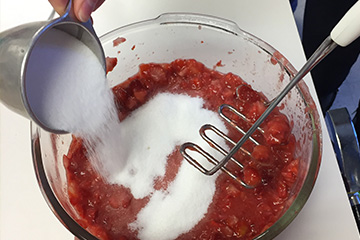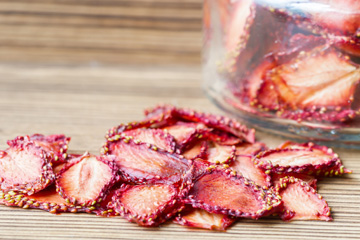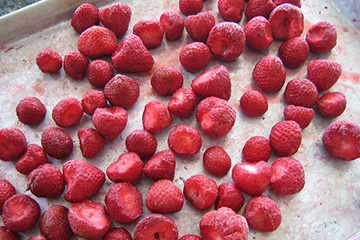
Making Sweet Spreads and Canning Fruit

Fruits contain natural sugar known as fructose. When we make canned jellies or sauces, we may add more sugar to help preserve, sweeten and maintain the quality of the fruit. Many people are paying more attention to the amount and type of sugar they consume. In commercially processed fruit or fruit spread this “added sugar” is included on the Nutrition Facts Label.
Granulated sugar often is used in home-canned foods. Corn syrup or mild-flavored honey can be used to replace part of the sugar (usually one-half) when preserving fruit. For best results, experts recommend using recipes that were created using honey or syrup. Some sweeteners can overpower the delicate flavor of fruit. Brown sugar and molasses usually are not recommended for use in preserving fruit because of their stronger flavor.
Besides providing sweetness, sugar helps preserve jams and jellies by preventing microorganisms from growing. Sugar plays an important role in creating gels through its interaction with commercial pectin and/or pectin naturally found in the fruit. The natural acid in fruit also is needed for gel formation.
In canned fruits such as peaches, sweetened syrups help maintain color, shape and flavor. The type of syrup varies from “very light” to “very heavy” according to the amount of water to sugar. “Light” syrups have less sugar and fewer calories than “heavy” syrup.
Canning With Less Sugar
Reduced-sugar recipes are available to make high-quality preserved products. Sometimes fruit juice can be used in place of syrup. Low-calorie liquid sweeteners and Splenda, which is a granular sugar substitute, can be used in jelly, jam and sauce recipes that were created using these products. Low – or no-sugar pectin is available to use with less sugar or artificial sweeteners. Do not reduce sugar or use artificial sweeteners with regular powdered or liquid pectin.
See these resources from the National Center for Home Food Preservation:
- See https://nchfp.uga.edu/how/can7_jam_jelly.html for several reduced-sugar recipes
- See https://nchfp.uga.edu/how/can_02/syrups.html for directions to prepare syrups.
Strawberry Season
Strawberries are a popular fruit and easy to preserve by drying, freezing, or making jam.
Choose fully ripe, firm berries with deep red color to preserve. Preserving will not improve the quality of any food.
Drying Strawberries Without Added Sugar

Dried strawberries are a fun snack or addition to baked goods, smoothies, granola, salads and yogurt.
Directions:
Wash hands and kitchen surfaces. Rinse strawberries under running water, remove caps and drain well. Cut strawberries into ½-inch slices or in half lengthwise. Small berries can be dried whole.
Place strawberries cut side up on dehydrator trays. Set the dehydrator temperature between 130–140 degrees F. For berries with 2 cut sides, turn berries halfway through the drying process, so they won’t stick to drying tray. Drying time varies, depending on size of pieces. Be sure to check after seven hours. For thick pieces, drying can take up to 36 hours. Cool fruit for 30 minutes.
Dried strawberries should be pliable and leathery with no moisture. Store in an airtight container or freeze for longer storage.
Freezing Strawberries Without Added Sugar

Frozen strawberries without added sugar can be used when you only want to take out a few strawberries at a time, as for smoothies. These strawberries will turn mushy if completely thawed, so they are best used cold. This method also works well to keep berries to make jam later.
Directions:
Wash hands and kitchen surfaces. Rinse strawberries under running water, remove caps and drain.Spread a single layer of berries on a baking sheet and freeze until solid (approx. one to two hours). Transfer berries to freezer bags. Press out as much air as possible.
Label all preserved items with product name and date. For more ways to preserve strawberries visit the National Center for Home Food Preservation or Cooperative Extension websites.
See https://www.ncrfsma.org/north-central-region-food-safety for food preservation information from the North Central Region.
More information:
- https://extension.umn.edu/preserving-and-preparing/drying-strawberries
- https://extension.psu.edu/drying-strawberries
- https://blogs.extension.iastate.edu/answerline/2019/05/13/freezing-strawberries/
- https://extension.psu.edu/freezing-strawberries
Using Frozen Fruit to make jam:
https://enewsletters.k-state.edu/youaskedit/2017/06/14/making-jam-jelly-with-frozen-fruit/